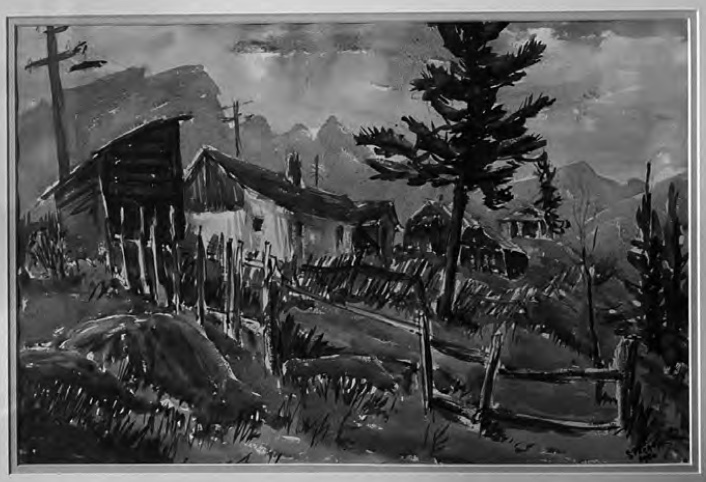Stan Perrott
Of the many inspirational people who have found their way to Bragg Creek, probably no other influenced art in this community more than Stan Perrott. Artists have long been drawn to the beauty of this area, but its hive of activity heightened in the 1960s through the 80s. During that time, Stan mentored many of Bragg Creek’s artists, including Ron Benstead, Ed Drahanchuk, Glenis Ingman Marshall, Dulcie Draper and Connie and Bob Pike. Former student Bob Pike recalls Stan, with enthusiasm: “He was the most amazing person you could meet, there was a 20-foot radius of happiness around him; [he was] an incredible mentor, teaching art was his calling and [he] knew the importance of the arts… he was solid gold.”
Born in 1917, the eldest son living on the family farm three miles southwest of Stavely, Stan would not become a farmer. He was not made for farm work, evident early that he possessed other special intellectual qualities. Friend Gitta Whillier adds, “along with a sparkling wit.”
He graduated in 1939 from the Provincial Institute of Technology and Art (later named the Alberta College of Art (ACA), ACAD, and now Alberta University of the Arts) where he studied under the tutelage of Marion Nicoll. He returned to teach at this school in 1946. In the 1950s, he travelled and studied with famous abstract expressionist painters, Hans Hofmann in Provincetown, and Will Barnet in New York. Stan was embraced by the art community and could have stayed in New York. His friends said, with his talent, he should have. However, he had a sense of obligation to the arts in Alberta and felt that’s where he belonged.
He spent 37 years as an educator at ACA guiding a generation of Alberta artists and was the head of the college from 1967 to 1974. His depth of knowledge of art was formidable, but so was his general range of knowledge of both events and people which made him a good storyteller and motivator. As a master he also understood the individuality of a student and the importance of empowerment. He was devoted to his students and he often helped deserving students with financial support if he knew they were struggling.
In the 1960s, Stan was instrumental in convincing the provincial government that the art section of the Provincial Institute needed its own building and thanks to him and his associates, the art college became a reality. He received many awards, including the 1988 Sir Frederick Haultain Prize for outstanding contribution art and education in Alberta. Stan is said to be one of the most important figures in the development of art in Alberta in the post-war period – as an influential art educator and master watercolourist.
In 1960, Stan paid $3200 for a small acreage with a one-room shack on Pine Avenue in the hamlet of Bragg Creek. Convinced and helped by former student and surrogate son Wayne Whillier, they converted it into a livable space and moved in that summer. Additions in the late 70s, 80s, 90s (with help from the Merryfields) included an airy studio, a tiled conservatory and rustic loft; there was art everywhere and an incredible garden. He proved to also be a master at gardening with wild and domestic flowers, while shrubs, water and rocks harmonized with the indigenous pines and spruces.
Wanting to promote art in Bragg Creek, he would help anyone, with talent or not. Stan would have you create something and bring it back to him. Then he’d encourage you to keep going with some new ideas. No matter the end result, Stan was so supportive that he would then often purchase these fine pieces of “local art.” He helped found the Bragg Creek Artisans in 1976 and later, the Bragg Creek Artisans Painting Group.
Stan had a long and somewhat interrupted journey toward his own artistic self-fulfillment. However, once he retired, his painting surged with more realistic depictions of landscapes, and scenes going back to his own roots, showing his fascination with trees. Like many farm dwellers, Perrott saw trees as an integral part of life. He produced major exhibitions, supplied paintings for the Leighton Centre near Millarville and his work found its way into private collections. His last major exhibition was in 1991 at McMaster University, where he exhibited 18 landscape watercolours.
Retirement also brought an endless cast of visitors who were always treated to unfailing hospitality. In 1988, for example, he averaged 4.6 visitors and 6.3 telephone calls per day and through the years requests for dinner engagements, often a prelude to a concert or play, averaged well over three a week. Dr. J. Stanford Perrott died in December 2001.
Michele McDonald
Foran, Maxwell, The Chalk & The Easel – The Life and Work of Stanford Perrott, University of Calgary Press, 2001; Wayne and Gitta Whillier, Interview October 17, 2021; Connie and Bob Pike, Interview October 24, 2021; “Perrott”, Obituary Calgary Herald, December 2001.


























